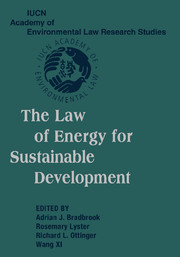Book contents
- Frontmatter
- Contents
- Acknowledgments
- Message from Kofi A. Annan, Secretary-General, United Nations
- Introduction – A Global Learned Society to Address Earth's Evolution: The IUCN Academy of Environmental Law
- Public Lectures on International Environmental Law
- PART ONE SUSTAINABLE DEVELOPMENT AND THE ROLE OF ENERGY LAW
- 1 Development and Energy
- 2 The Imperatives of Energy for Sustainable Development
- 3 2020 Energy Demand of China and Energy Conservation
- 4 Sustainable Development and the Marrakech Accords
- 5 Ethical Implications
- 6 Technological Implications
- PART TWO LEGAL ISSUES IN CONTEMPORARY ENERGY LAW
- PART THREE INTERNATIONAL ENERGY LAW
- PART FOUR COMPARATIVE ENERGY LAW
- PART FIVE ELECTRICITY RESTRUCTURING
- PART SIX FINANCING FOR SUSTAINABLE ENERGY
- PART SEVEN CIVIL SOCIETY AND THE PROCEDURAL REQUIREMENTS OF ENERGY LAW FOR SUSTAINABLE DEVELOPMENT
- Index
3 - 2020 Energy Demand of China and Energy Conservation
Published online by Cambridge University Press: 10 August 2009
- Frontmatter
- Contents
- Acknowledgments
- Message from Kofi A. Annan, Secretary-General, United Nations
- Introduction – A Global Learned Society to Address Earth's Evolution: The IUCN Academy of Environmental Law
- Public Lectures on International Environmental Law
- PART ONE SUSTAINABLE DEVELOPMENT AND THE ROLE OF ENERGY LAW
- 1 Development and Energy
- 2 The Imperatives of Energy for Sustainable Development
- 3 2020 Energy Demand of China and Energy Conservation
- 4 Sustainable Development and the Marrakech Accords
- 5 Ethical Implications
- 6 Technological Implications
- PART TWO LEGAL ISSUES IN CONTEMPORARY ENERGY LAW
- PART THREE INTERNATIONAL ENERGY LAW
- PART FOUR COMPARATIVE ENERGY LAW
- PART FIVE ELECTRICITY RESTRUCTURING
- PART SIX FINANCING FOR SUSTAINABLE ENERGY
- PART SEVEN CIVIL SOCIETY AND THE PROCEDURAL REQUIREMENTS OF ENERGY LAW FOR SUSTAINABLE DEVELOPMENT
- Index
Summary
Chinese energy strategy must begin with an analysis of the county's current and future demand for energy. A rapid rise in energy demand is the key driving force for the development of an energy strategy. There is not only one possible future for China. The goal is to keep energy elasticity at 0.5 for the next twenty years. But is it possible to achieve this target?
Table 3.1 shows the year 2000 China energy demand by resource and the projected demand for years 2010 and 2020.
The range of energy demand in China in 2020 by resource is: coal, about 18.5 to 28.5 million tons; oil, 400 to 520 million tons; natural gas, 120 to 200 billion cubic meters; primary electricity (hydro, nuclear, renewables), 1080 to 1400 twh; hydropower, 220 to 240 gw; nuclear, 30 to 40 gw; and wind, 15 to 30 gw.
Keeping low energy elasticity is possible. Total energy demand is projected at 2.4 to 3.1 billion tce, but it is not certain that it will stay lower than 3.1 billion. There is a strong need for energy conservation, a high-quality energy mix, strict environmental policy, and effective enforcement. There needs to be significant change in the mix of energy, for example, coal from seventy to fifty-five percent, natural gas from five to ten percent, and primary electricity from six to ten percent. There will be an increase in need for imported oil and gas. If total energy demand increases greatly, the demand for coal will rise.
- Type
- Chapter
- Information
- The Law of Energy for Sustainable Development , pp. 53 - 55Publisher: Cambridge University PressPrint publication year: 2005

